TOYOTA VERSO 2012 Owners Manual
Manufacturer: TOYOTA, Model Year: 2012, Model line: VERSO, Model: TOYOTA VERSO 2012Pages: 588, PDF Size: 31.32 MB
Page 131 of 588
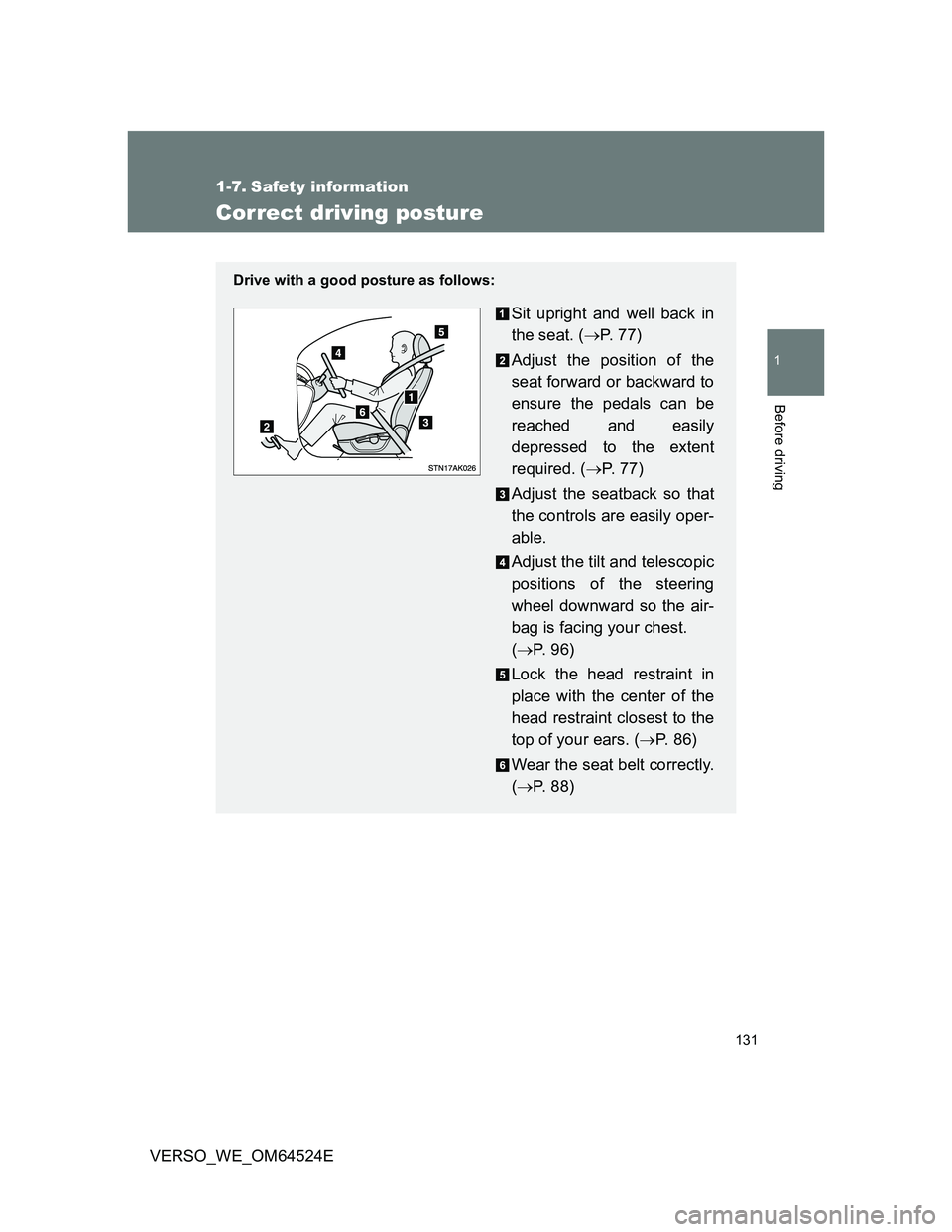
131
1
Before driving
VERSO_WE_OM64524E
1-7. Safety information
Correct driving posture
Drive with a good posture as follows:
Sit upright and well back in
the seat. (P. 7 7 )
Adjust the position of the
seat forward or backward to
ensure the pedals can be
reached and easily
depressed to the extent
required. (P. 77)
Adjust the seatback so that
the controls are easily oper-
able.
Adjust the tilt and telescopic
positions of the steering
wheel downward so the air-
bag is facing your chest.
(P. 96)
Lock the head restraint in
place with the center of the
head restraint closest to the
top of your ears. (P. 86)
Wear the seat belt correctly.
(P. 88)
Page 132 of 588
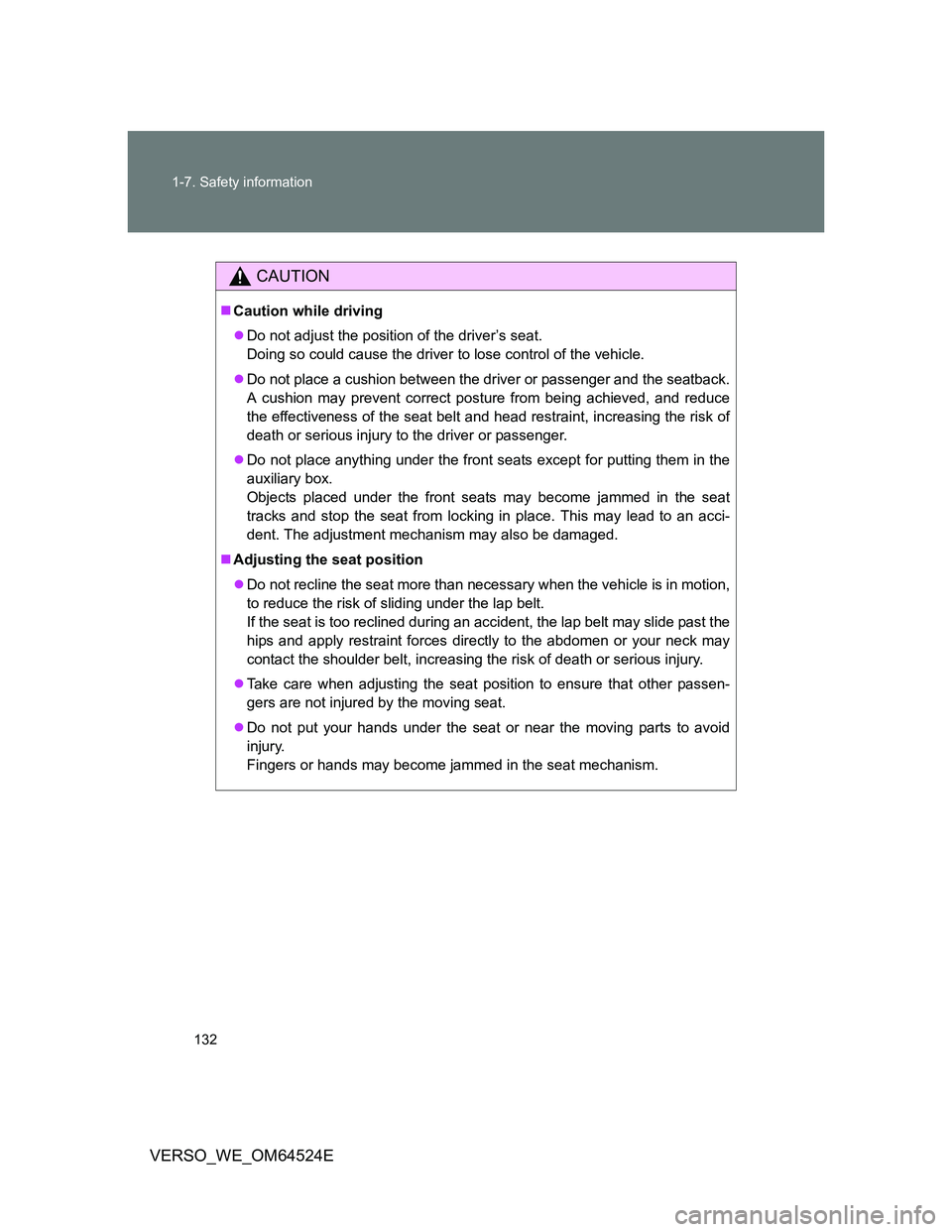
132 1-7. Safety information
VERSO_WE_OM64524E
CAUTION
Caution while driving
Do not adjust the position of the driver’s seat.
Doing so could cause the driver to lose control of the vehicle.
Do not place a cushion between the driver or passenger and the seatback.
A cushion may prevent correct posture from being achieved, and reduce
the effectiveness of the seat belt and head restraint, increasing the risk of
death or serious injury to the driver or passenger.
Do not place anything under the front seats except for putting them in the
auxiliary box.
Objects placed under the front seats may become jammed in the seat
tracks and stop the seat from locking in place. This may lead to an acci-
dent. The adjustment mechanism may also be damaged.
Adjusting the seat position
Do not recline the seat more than necessary when the vehicle is in motion,
to reduce the risk of sliding under the lap belt.
If the seat is too reclined during an accident, the lap belt may slide past the
hips and apply restraint forces directly to the abdomen or your neck may
contact the shoulder belt, increasing the risk of death or serious injury.
Take care when adjusting the seat position to ensure that other passen-
gers are not injured by the moving seat.
Do not put your hands under the seat or near the moving parts to avoid
injury.
Fingers or hands may become jammed in the seat mechanism.
Page 133 of 588
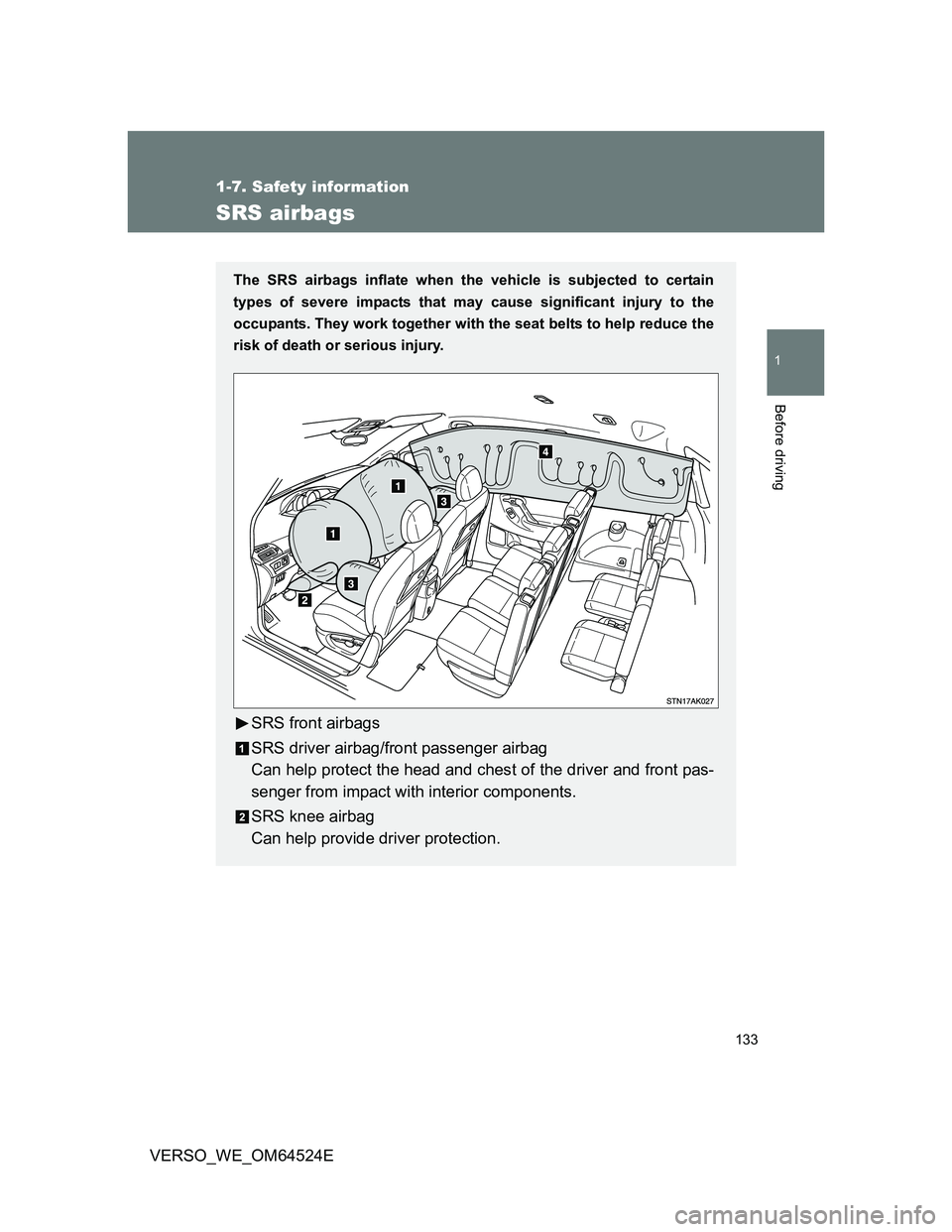
133
1
1-7. Safety information
Before driving
VERSO_WE_OM64524E
SRS airbags
The SRS airbags inflate when the vehicle is subjected to certain
types of severe impacts that may cause significant injury to the
occupants. They work together with the seat belts to help reduce the
risk of death or serious injury.
SRS front airbags
SRS driver airbag/front passenger airbag
Can help protect the head and chest of the driver and front pas-
senger from impact with interior components.
SRS knee airbag
Can help provide driver protection.
Page 134 of 588
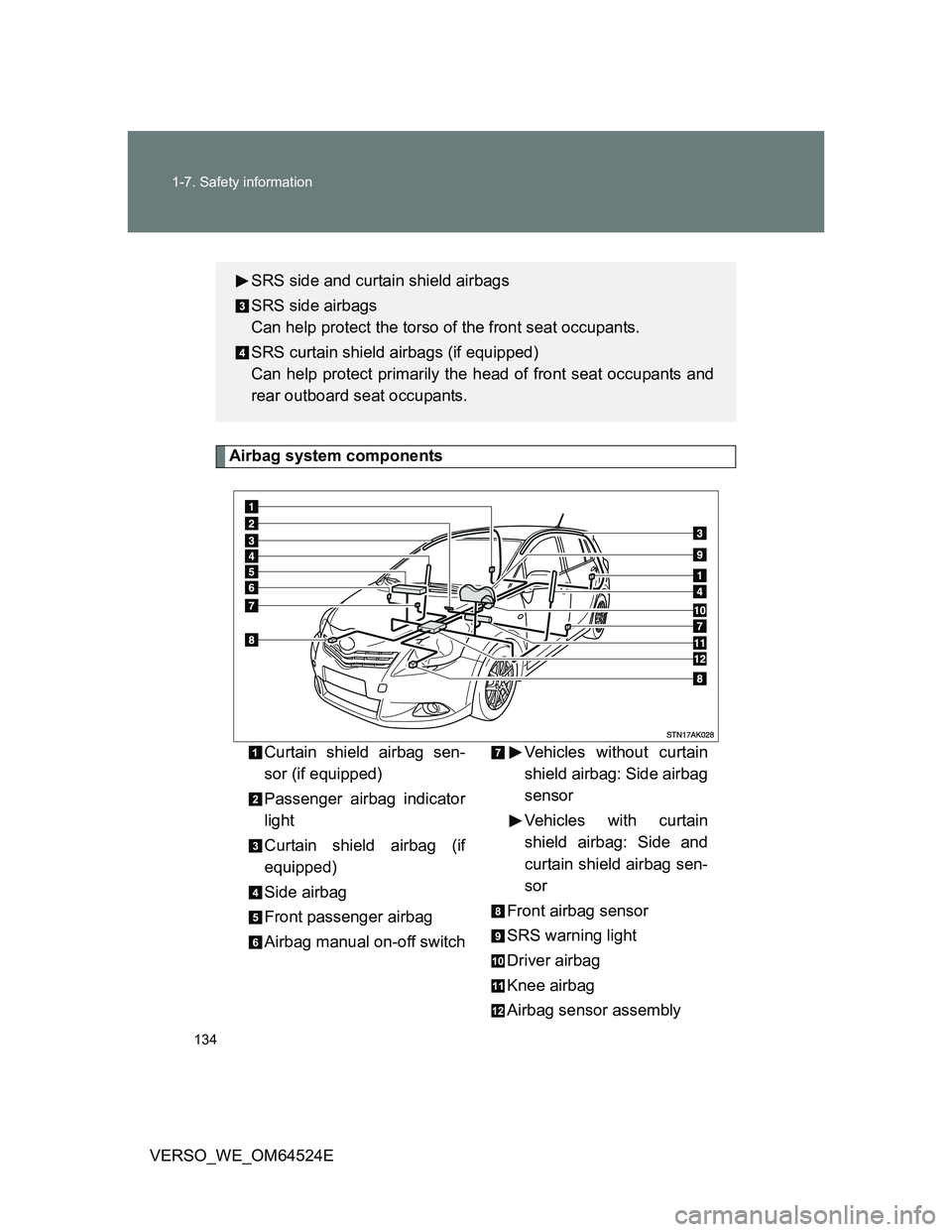
134 1-7. Safety information
VERSO_WE_OM64524E
Airbag system components
Curtain shield airbag sen-
sor (if equipped)
Passenger airbag indicator
light
Curtain shield airbag (if
equipped)
Side airbag
Front passenger airbag
Airbag manual on-off switchVehicles without curtain
shield airbag: Side airbag
sensor
Vehicles with curtain
shield airbag: Side and
curtain shield airbag sen-
sor
Front airbag sensor
SRS warning light
Driver airbag
Knee airbag
Airbag sensor assembly
SRS side and curtain shield airbags
SRS side airbags
Can help protect the torso of the front seat occupants.
SRS curtain shield airbags (if equipped)
Can help protect primarily the head of front seat occupants and
rear outboard seat occupants.
Page 135 of 588
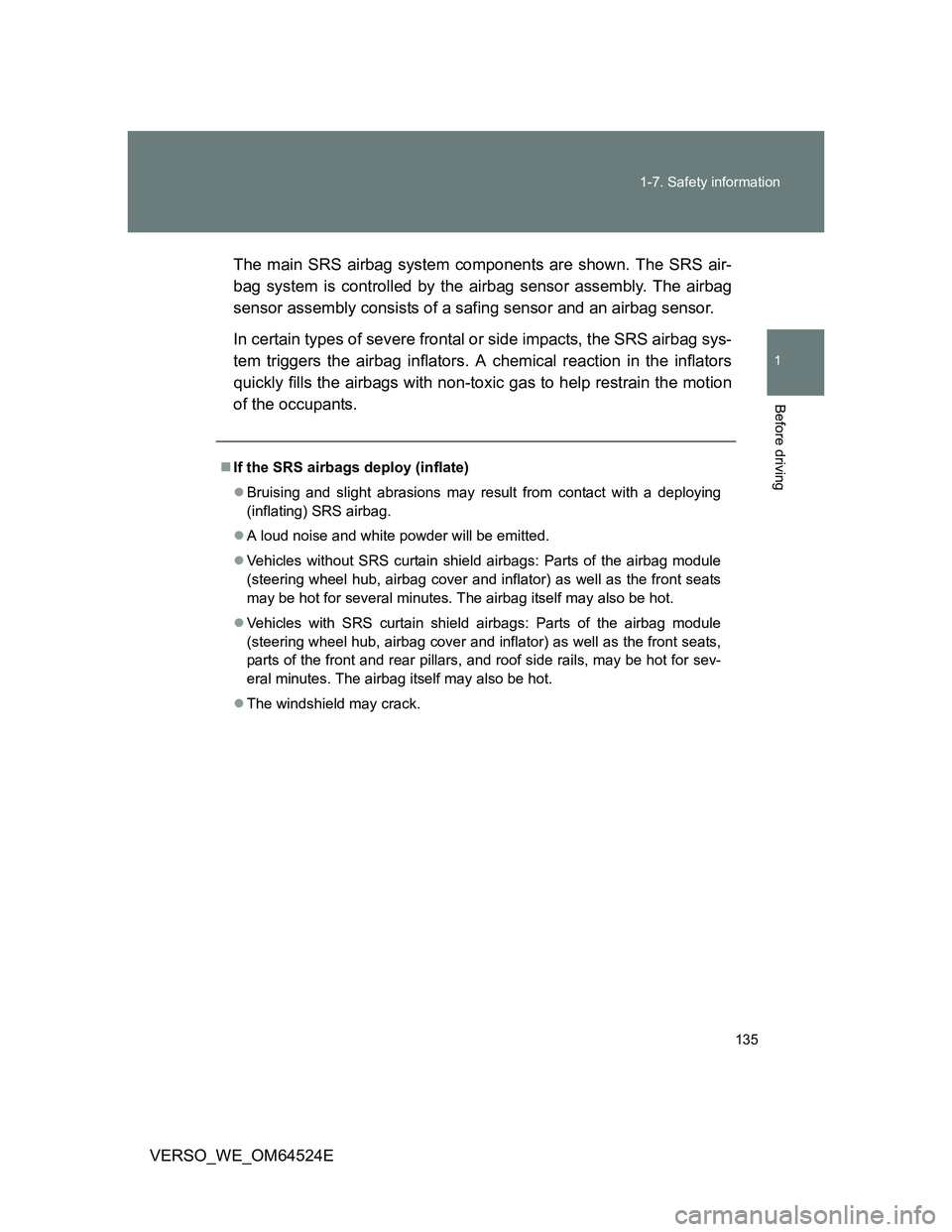
135 1-7. Safety information
1
Before driving
VERSO_WE_OM64524EThe main SRS airbag system components are shown. The SRS air-
bag system is controlled by the airbag sensor assembly. The airbag
sensor assembly consists of a safing sensor and an airbag sensor.
In certain types of severe frontal or side impacts, the SRS airbag sys-
tem triggers the airbag inflators. A chemical reaction in the inflators
quickly fills the airbags with non-toxic gas to help restrain the motion
of the occupants.
If the SRS airbags deploy (inflate)
Bruising and slight abrasions may result from contact with a deploying
(inflating) SRS airbag.
A loud noise and white powder will be emitted.
Vehicles without SRS curtain shield airbags: Parts of the airbag module
(steering wheel hub, airbag cover and inflator) as well as the front seats
may be hot for several minutes. The airbag itself may also be hot.
Vehicles with SRS curtain shield airbags: Parts of the airbag module
(steering wheel hub, airbag cover and inflator) as well as the front seats,
parts of the front and rear pillars, and roof side rails, may be hot for sev-
eral minutes. The airbag itself may also be hot.
The windshield may crack.
Page 136 of 588
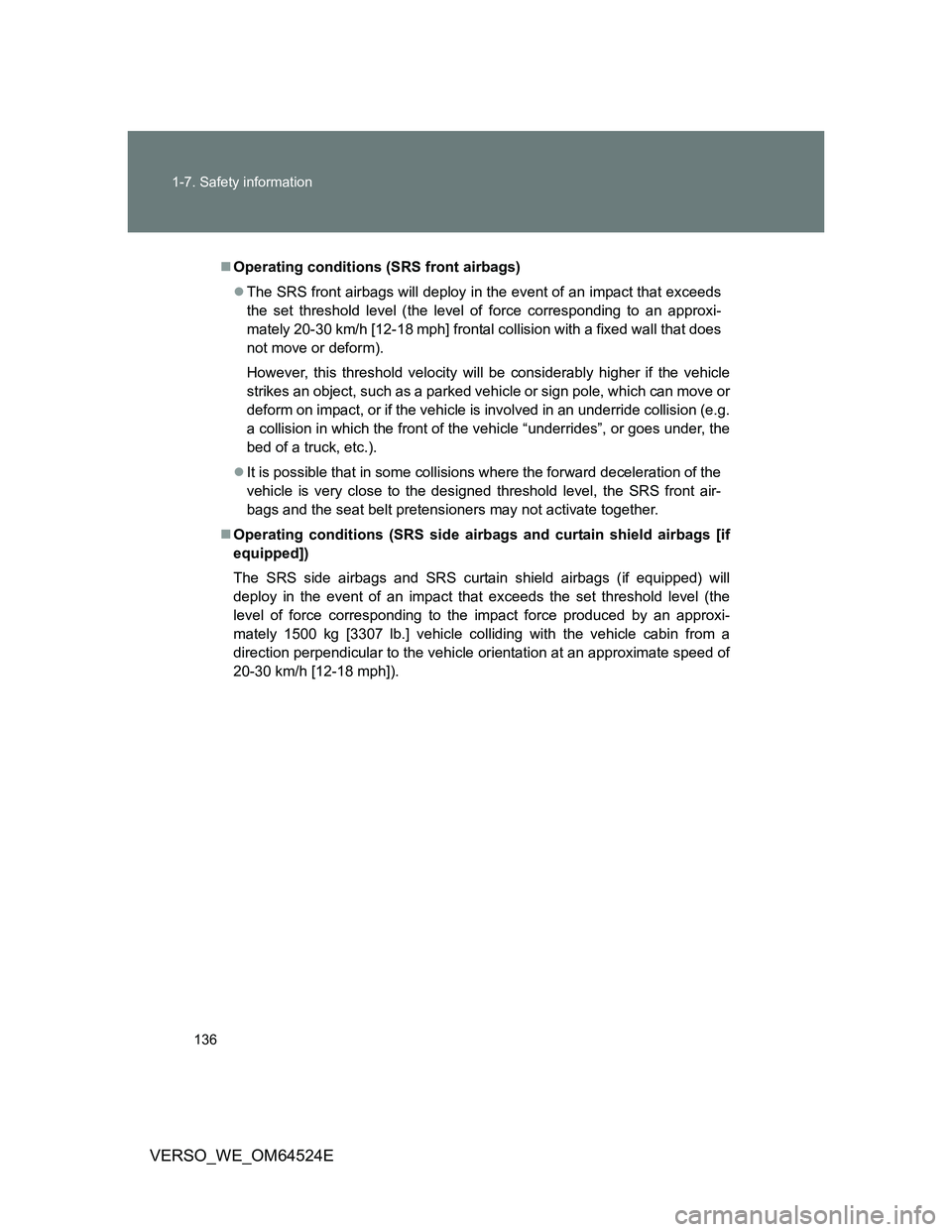
136 1-7. Safety information
VERSO_WE_OM64524E
Operating conditions (SRS front airbags)
The SRS front airbags will deploy in the event of an impact that exceeds
the set threshold level (the level of force corresponding to an approxi-
mately 20-30 km/h [12-18 mph] frontal collision with a fixed wall that does
not move or deform).
However, this threshold velocity will be considerably higher if the vehicle
strikes an object, such as a parked vehicle or sign pole, which can move or
deform on impact, or if the vehicle is involved in an underride collision (e.g.
a collision in which the front of the vehicle “underrides”, or goes under, the
bed of a truck, etc.).
It is possible that in some collisions where the forward deceleration of the
vehicle is very close to the designed threshold level, the SRS front air-
bags and the seat belt pretensioners may not activate together.
Operating conditions (SRS side airbags and curtain shield airbags [if
equipped])
The SRS side airbags and SRS curtain shield airbags (if equipped) will
deploy in the event of an impact that exceeds the set threshold level (the
level of force corresponding to the impact force produced by an approxi-
mately 1500 kg [3307 lb.] vehicle colliding with the vehicle cabin from a
direction perpendicular to the vehicle orientation at an approximate speed of
20-30 km/h [12-18 mph]).
Page 137 of 588
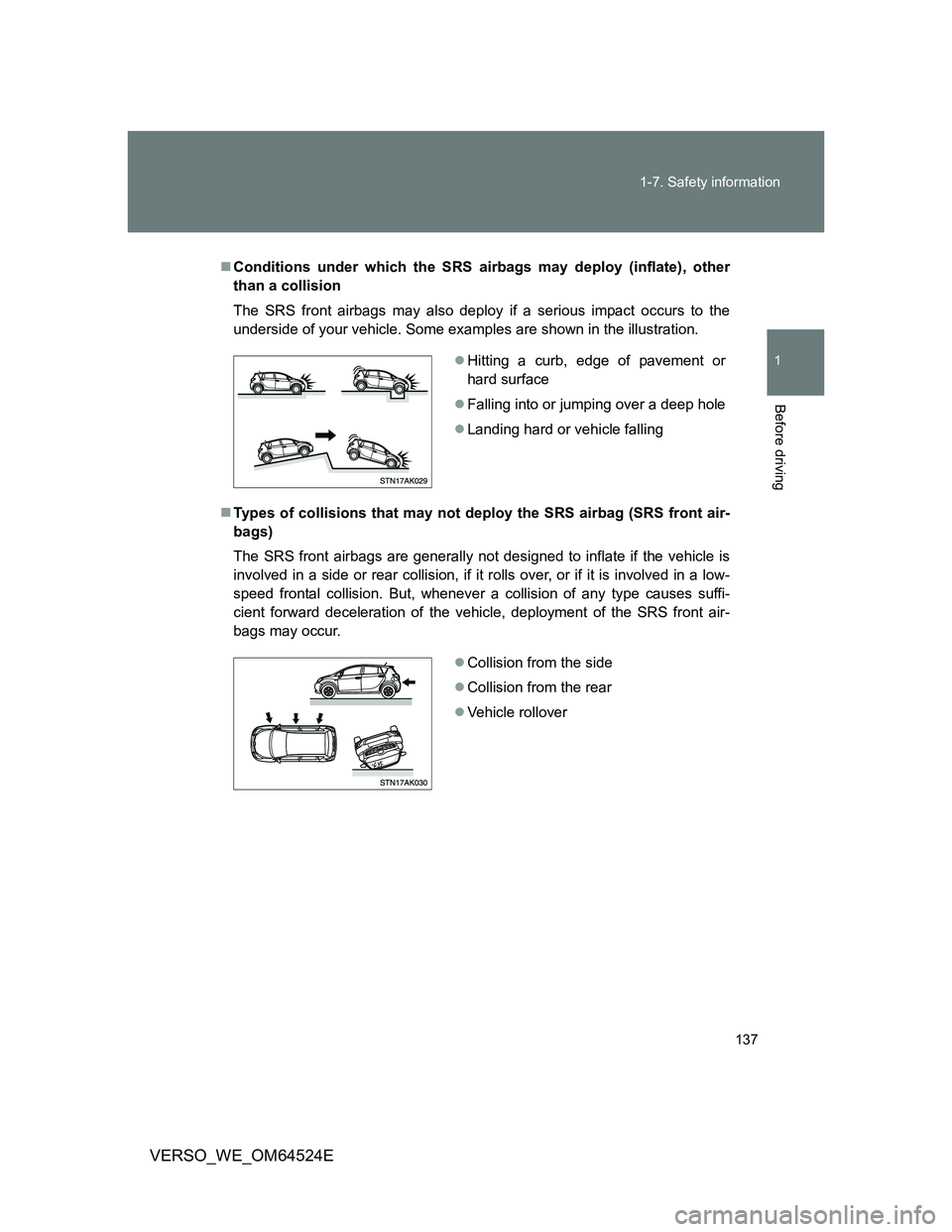
137 1-7. Safety information
1
Before driving
VERSO_WE_OM64524E
Conditions under which the SRS airbags may deploy (inflate), other
than a collision
The SRS front airbags may also deploy if a serious impact occurs to the
underside of your vehicle. Some examples are shown in the illustration.
Types of collisions that may not deploy the SRS airbag (SRS front air-
bags)
The SRS front airbags are generally not designed to inflate if the vehicle is
involved in a side or rear collision, if it rolls over, or if it is involved in a low-
speed frontal collision. But, whenever a collision of any type causes suffi-
cient forward deceleration of the vehicle, deployment of the SRS front air-
bags may occur.
Hitting a curb, edge of pavement or
hard surface
Falling into or jumping over a deep hole
Landing hard or vehicle falling
Collision from the side
Collision from the rear
Vehicle rollover
Page 138 of 588
![TOYOTA VERSO 2012 Owners Manual 138 1-7. Safety information
VERSO_WE_OM64524E
Types of collisions that may not deploy the SRS airbag
(SRS side airbags and curtain shield airbags [if equipped])
The SRS side airbag and curtain shi TOYOTA VERSO 2012 Owners Manual 138 1-7. Safety information
VERSO_WE_OM64524E
Types of collisions that may not deploy the SRS airbag
(SRS side airbags and curtain shield airbags [if equipped])
The SRS side airbag and curtain shi](/img/14/49112/w960_49112-137.png)
138 1-7. Safety information
VERSO_WE_OM64524E
Types of collisions that may not deploy the SRS airbag
(SRS side airbags and curtain shield airbags [if equipped])
The SRS side airbag and curtain shield airbag (if equipped) system may not
activate if the vehicle is subjected to a collision from the side at certain
angles, or a collision to the side of the vehicle body other than the passenger
compartment.
The SRS side airbags and curtain shield airbags (if equipped) are generally
not designed to inflate if the vehicle is involved in a frontal or rear collision, if
it rolls over, or if it is involved in a low-speed side collision.
Collision from the side to the vehicle
body other than the passenger com-
partment
Collision from the side at an angle
Collision from the front
Collision from the rear
Vehicle rollover
Page 139 of 588
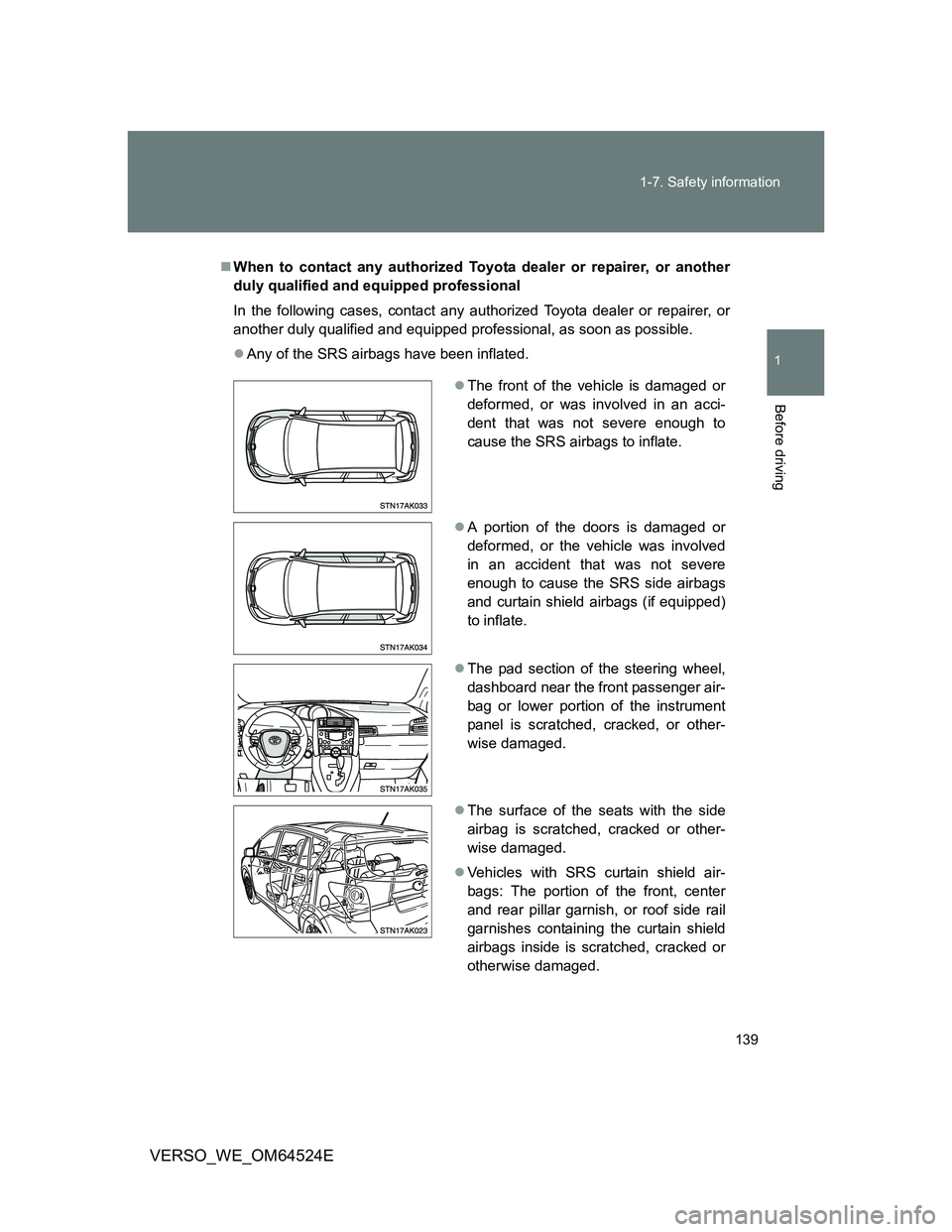
139 1-7. Safety information
1
Before driving
VERSO_WE_OM64524E
When to contact any authorized Toyota dealer or repairer, or another
duly qualified and equipped professional
In the following cases, contact any authorized Toyota dealer or repairer, or
another duly qualified and equipped professional, as soon as possible.
Any of the SRS airbags have been inflated.
The front of the vehicle is damaged or
deformed, or was involved in an acci-
dent that was not severe enough to
cause the SRS airbags to inflate.
A portion of the doors is damaged or
deformed, or the vehicle was involved
in an accident that was not severe
enough to cause the SRS side airbags
and curtain shield airbags (if equipped)
to inflate.
The pad section of the steering wheel,
dashboard near the front passenger air-
bag or lower portion of the instrument
panel is scratched, cracked, or other-
wise damaged.
The surface of the seats with the side
airbag is scratched, cracked or other-
wise damaged.
Vehicles with SRS curtain shield air-
bags: The portion of the front, center
and rear pillar garnish, or roof side rail
garnishes containing the curtain shield
airbags inside is scratched, cracked or
otherwise damaged.
Page 140 of 588
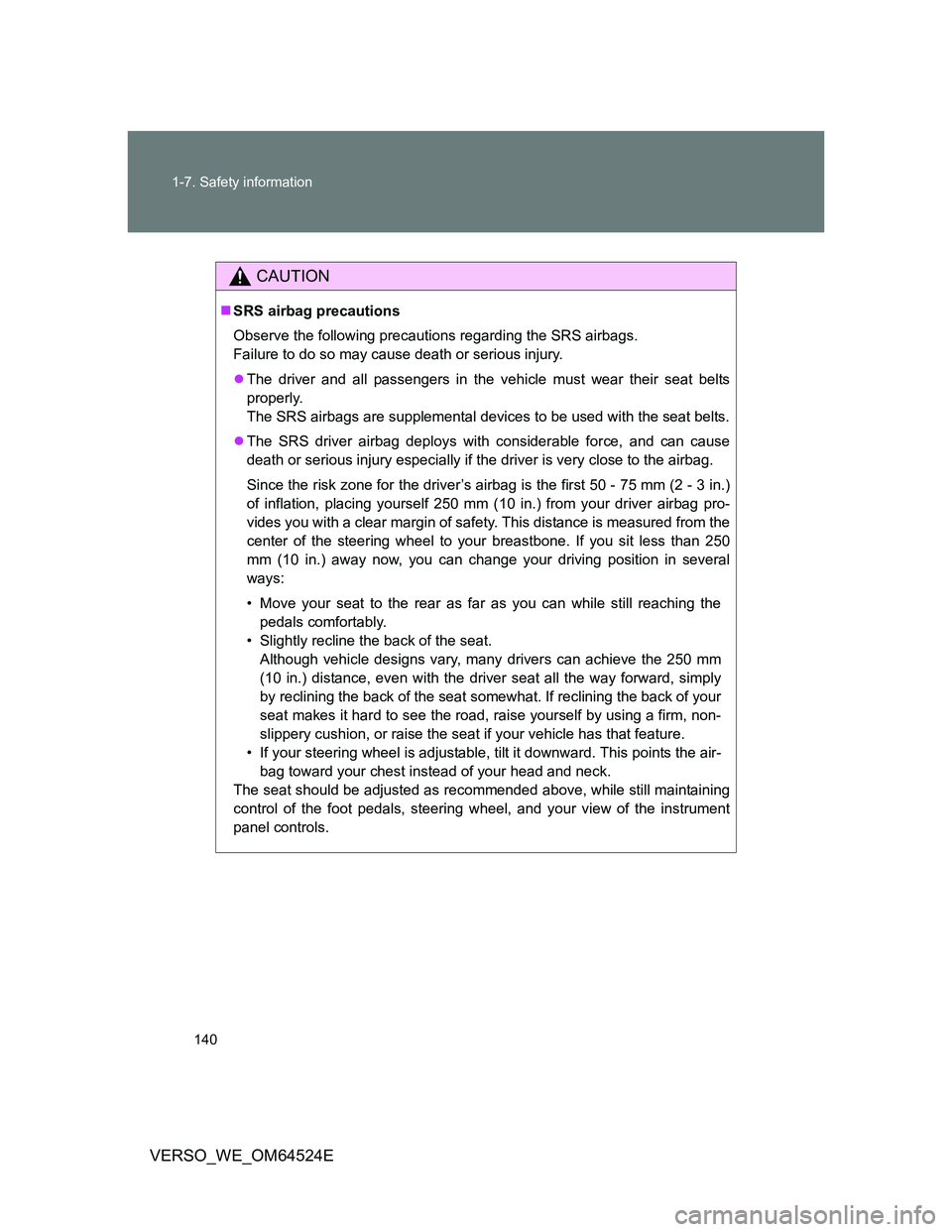
140 1-7. Safety information
VERSO_WE_OM64524E
CAUTION
SRS airbag precautions
Observe the following precautions regarding the SRS airbags.
Failure to do so may cause death or serious injury.
The driver and all passengers in the vehicle must wear their seat belts
properly.
The SRS airbags are supplemental devices to be used with the seat belts.
The SRS driver airbag deploys with considerable force, and can cause
death or serious injury especially if the driver is very close to the airbag.
Since the risk zone for the driver’s airbag is the first 50 - 75 mm (2 - 3 in.)
of inflation, placing yourself 250 mm (10 in.) from your driver airbag pro-
vides you with a clear margin of safety. This distance is measured from the
center of the steering wheel to your breastbone. If you sit less than 250
mm (10 in.) away now, you can change your driving position in several
ways:
• Move your seat to the rear as far as you can while still reaching the
pedals comfortably.
• Slightly recline the back of the seat.
Although vehicle designs vary, many drivers can achieve the 250 mm
(10 in.) distance, even with the driver seat all the way forward, simply
by reclining the back of the seat somewhat. If reclining the back of your
seat makes it hard to see the road, raise yourself by using a firm, non-
slippery cushion, or raise the seat if your vehicle has that feature.
• If your steering wheel is adjustable, tilt it downward. This points the air-
bag toward your chest instead of your head and neck.
The seat should be adjusted as recommended above, while still maintaining
control of the foot pedals, steering wheel, and your view of the instrument
panel controls.